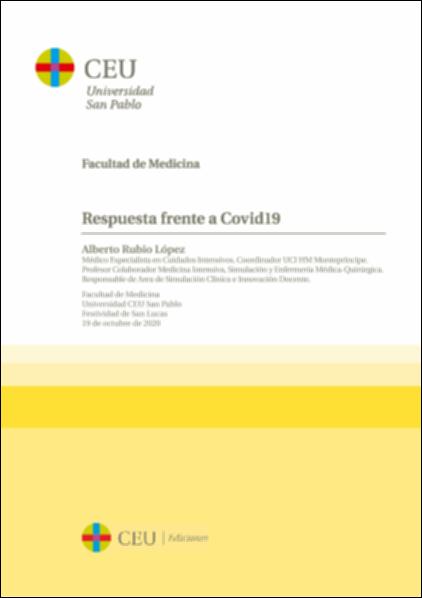Please use this identifier to cite or link to this item:
http://hdl.handle.net/10637/11671Respuesta frente al Covid19.
| Title: | Respuesta frente al Covid19. |
| Authors : | Rubio López, Alberto |
| Keywords: | COVID-19.; Pandemia.; Coronavirus pandemic. |
| Publisher: | Madrid : CEU Ediciones, D.L. 2020. |
| Abstract: | En la enfermedad producida por el SARS-Cov2 (COVID19) la afectación
fundamental se produce en personas de edad avanzada, siendo éste el principal
grupo de riesgo con mucha diferencia respecto a los demás grupos poblacionales.
Además su mortalidad se incrementa de forma significativa entre aquellos
pacientes que presentan factores de riesgo prexistentes: hipertensión, diabetes,
otras enfermedades cardiovasculares, obesidad, nefropatía o cirrosis hepática1.
La forma de transmisión es a través de macro (> 5 μm) y microgotas (< 5 μm de
diámetro), que se liberan durante la tos, estornudos, conversación en voz alta o
canto, en especial en ausencia de utilización de métodos de barrera (mascarillas)
y en ambientes cerrados y con poca ventilación y distancia social.
Existe un período de incubación medio de 5 días, durante el cual los pacientes
pueden transmitir la enfermedad. Sin embargo, la forma de transmisión no es
igual en todos los casos: existe cada vez mayor evidencia científica que en un
80% de los casos, la transmisión de produce con una R0 de 1 (es decir, cada paciente
infectado contagia a una sola persona); mientras que en el 20% restante se
produciría un contagio con una R0 muy superior; se trataría de pacientes superpropagadores,
responsables de la expansión en brotes o clusters, característica
de esta enfermedad. In the disease produced by SARS-Cov2 (COVID19) the affectation fundamental occurs in elderly people, this being the main risk group with a great difference with respect to the other population groups. In addition, their mortality increases significantly among those patients with pre-existing risk factors: hypertension, diabetes, other cardiovascular diseases, obesity, nephropathy or liver cirrhosis1. The form of transmission is through macro (> 5 μm) and microdroplets (<5 μm of diameter), which are released during coughing, sneezing, loud conversation or edge, especially in the absence of barrier methods (masks) and in closed environments with little ventilation and social distance. There is a mean incubation period of 5 days, during which patients they can transmit the disease. However, the way of transmission is not the same in all cases: there is increasing scientific evidence that in a 80% of cases, transmission occurs with an R0 of 1 (that is, each patient infected infects a single person); while in the remaining 20% it would produce a contagion with a much higher R0; it would be super-spreading patients, responsible for the expansion in shoots or clusters, characteristic of this disease. |
| Description: | [Lección magistral en la] festividad de San Lucas, Facultad de Medicina, Universidad CEU San Pablo, 19 de octubre 2020, [20 pp.] |
| URI: | http://hdl.handle.net/10637/11671 |
| Rights : | http://creativecommons.org/licenses/by-nc-nd/4.0/deed.es |
| Issue Date: | 19-Oct-2020 |
| Center : | Universidad San Pablo-CEU |
| Appears in Collections: | Lecciones magistrales y memorias |
Items in DSpace are protected by copyright, with all rights reserved, unless otherwise indicated.


